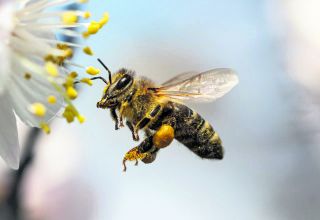
Rosi Rollings has been a passionate plantswoman and gardener all her life, and in 2008 became a beekeeper. A year later she started Rosybee: Plants for Bees nursery in Wantage, Oxfordshire when she could not find a good source of plants for bees
If you regularly read any of the gardening magazines you will probably have seen articles about the decline of bees and how important they are to the general health of the planet as well as roughly a third of human food supply.
A lot is talked about bee’s diseases and pesticides; all of which are certainly important factors. However there is one stunning fact which gets less press coverage and that is the massive loss of flowers since the Second World War; 97 per cent of lowland meadows have disappeared as well as a very high proportion of hedgerows and woodlands; pastures and hedges have been replaced by much larger fields of wheat or other grass-crops that have no value to bees.
Our government has produced a worthy Pollinator Strategy which will, over time, influence environmental management policies which will help to replace flowering plants in areas of farmed land, roadside verges, etc. But gardens make up a large percentage of the country and can be have much more floral intensity than most meadows which are essentially mainly grass.
I have always been a passionate gardener but in 2008 I also became a beekeeper and so began to be more aware of these issues. I found it quite frustrating that the information for gardeners on how to provide more value to bees through our gardens was confusing and did not appear to have been written with much empathy for gardeners.
Here is the most commonly stated guidance for supporting bees and some of the issues:
“Plant more of the right plants” – great but which ones?
There many different lists of recommended plants and advice that you should let your grass get long and scruffy.
A PhD student at Sussex University’s Laboratory of Apiculture and Social Insects (LASI) did a study of some the lists of recommended plants for bees from 15 highly qualified sources. He found that only one plant appeared on all 15 lists and that only one source attempted to quantify the relative value of the plants. Almost all the lists were based on anecdotes or the author’s observations but none with empiric evidence.
In this country the RHS publishes a list of over 300 plants including trees and shrubs; the list is actively managed by their chief entomologist and only contains plants that are noted to attract bees. However, the problem with even this list is the implication that all the plants on it are of equal value.
“Let your grass grow long” – what will that do to help?
In most lawns there will be a certain amount of clover and other flowering species but if you have spent years carefully eliminating these to have the perfect lawn or have good fertile soil under your grass, the amount of extra flower you will get by leaving it long will be minimal. I tried this and really enjoyed the effect with a meandering path mown through it. It was interesting to see what came up until it got above knee height, got flattened by the rain and then became a yellowing mess that took months to stop being an eye-sore. Surely you can always get more flowers crambed into any border than you can from your lawn. However, clover specifically, is very good for bumblebees so maybe allow a small corner to establish in a sunny spot.
“Grow more native plant’s” – does that mean more weeds?
Another regularly stated piece of advice is to add native plants for bees. There is no evidence that UK native plants (which means the plant was already present in these islands before the land mass separated from continental Europe 9,000 years ago!) In fact there is growing evidence that the bees do not care about the origin of the plant. When you consider that many of the bee species are not native themselves, this makes sense; most of our honey bees are European as are several of our bumblebees.
So, having read all the lists and all the advice and walked round the garden centres I was still convinced that us gardeners can help bees if we know what plants can provide the most nectar and pollen in our gardens. I also decided the only way to find out which plants those were was to grow them myself and try and work out how to quantify which attracted the most bees.
Now, five years on and with a little guidance from LASI, I now run a plant nursery that specialises in growing the right plants and I have two years worth of field data completed to back up our claims. We have found that
- not all recommended plants are equally attractive to bees (in fact some are rubbish)
- native plants are not better than non-native; the specific species is much more important
- plants that will grow happily in grass are not some of the most attractive to bees.
- healthy plants attract more bees than unhappy ones so consider your soil and conditions rather than just the bees preferences.
Over the last 3 years we have tested (in our heavy Oxfordshire clay) over 80 plants selected from the lists of plants recommended for bees. We count bees per square metre of each plant for every week the plant is in flower.











